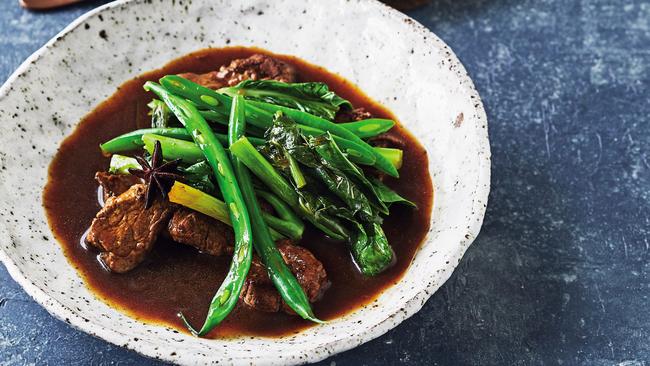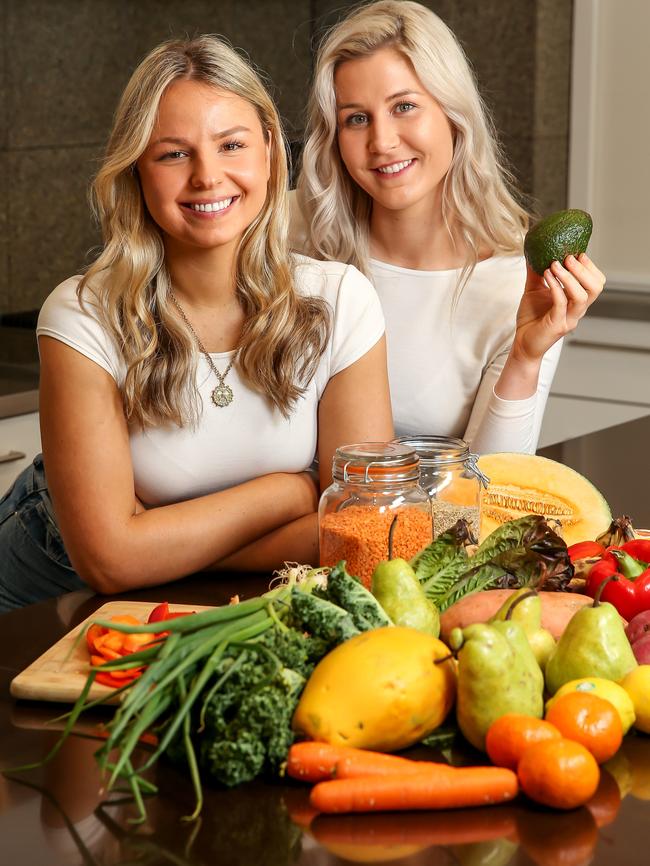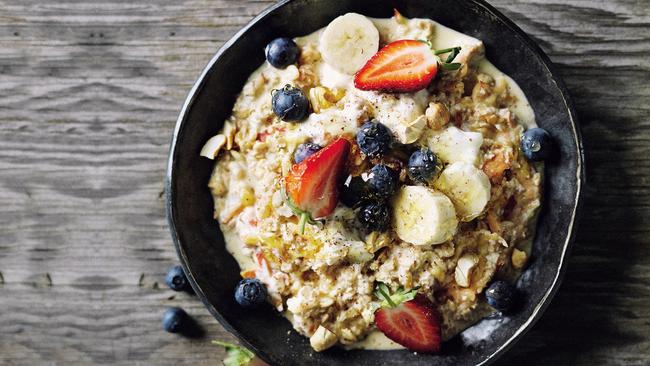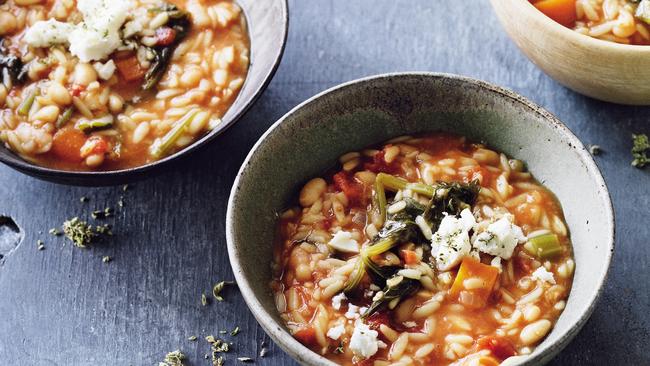Eat your way to good health with CSIRO gut diet
GROWING research is finding that the health of your gut can directly affect everything from our immunity, brain, heart, allergy risk and risk of inflammatory conditions. Find out which foods act as fertiliser for nurturing good bacteria. + RECIPES.
News
Don't miss out on the headlines from News . Followed categories will be added to My News.
THE gut — and the constellation of bacteria that live inside it — has emerged as one of the most powerful and promising ways of using diet to prevent and reverse many chronic diseases.
Growing research from around world, including from Melbourne laboratories, is finding that the health of our gut — either losing good bacteria or by having the wrong mix — can directly affect everything from our immunity, brain, heart, allergy risk and risk of inflammatory conditions.
The CSIRO has released a new evidence-backed meal plan, the Healthy Gut Diet, which promotes foods that act as fertiliser for nurturing good bacteria in the gut.

While public health campaigns mean most Australians will associate fibre with “roughage” — the indigestible part of plant foods that keep us “regular” — it is a particular type of fibre called “resistant starch” that researchers say is the major piece in the gut health puzzle.
Co-author Pennie Taylor, a research and practising dietitian in CSIRO’s Nutrition and Health program, said Australia may have one of the highest fibre consumptions in the western world, but our high rate of colorectal cancer suggests we have more work to do.
“We’re still not getting the fibre diversity we need,” Ms Taylor said.
“The best fibre we found that can feed the gut, keep it healthy and protect the gut lining, is resistant starch.
“Some fibres digest in then upper GI tract, whereas resistant starch goes all the way through the bowel and causes fermentation which feeds the bacteria to prevent inflammation.
“That’s the story the general population are missing.”
Ms Taylor said there was growing evidence that the role of the universe of bacteria in the digestive system goes beyond processing food and drink.
Dietary fibre and the by-products produced by the gut in this fermentation process can influence composition of gut microbiotia.
Mice have been able to be protected from developing diabetes, asthma, inflammatory bowel disease, food allergies and obesity simply by changing the composition of bacteria in their digestive tract, in studies at Monash University.
Researchers at the Walter and Eliza Hall Institute of Medical Research are looking at whether a mother’s diet, and consequently the microbes in her gut, can predispose her children to allergies or type 1 diabetes.

Over at the Baker Heart and Diabetes Institute, they have found in animal models that a mother’s high fibre diet can protect offspring against heart failure.
“The gastrointestinal system is a complete system, an organ, and inside that you have a number of bacteria and microorganisms that emulsify food ” she said.
“When these come under threat and there is a disruption of the gut microbiotia, we call this inflammation.
“When the lining is inflamed, there is a poor absorption of nutrients, but it also leads to chronic disease like obesity and cardiovascular disease.”
Dietary guidelines say the average woman needs 25g of fibre a day, and 30g for men — but four out of five Australians consume just 20g.
They’re missing a slice or two of wholegrain bread, a serving of legumes, mixed cup of peas, corn and carrots, or a bowl or banana porridge.
But Ms Taylor said for adults with chronic diseases such as cardiovascular disease, diabetes or obesity, their fibre intake should be increased to 28g for women and 38g for men.
Food such as under-ripe bananas, peas, beans, cashews and rolled oats are high in this beneficial fibre.
And while the amount of resistant starch is influenced by how it’s stored, prepared and reheated, cooking and cooling potatoes, sweet potatoes, rice and pasta before eating — even if they are reheated before consuming — can marginally increase the amount of resistant starch these foods contain.
Ms Taylor said while some people were reluctant to increase their fibre intake for fear of experiencing
“Digestion does involve some gas, but you should feel comfortable within that,” she said.
“Our gut is really important long term, like our back. You can’t do a lot in life without a good back, and you can’t have a healthy lifestyle without a good gut.”
THE GUT AS THE BODY’S SECOND BRAIN

WHEN Sarah Brown ditched her regular dinners of wedges and schnitzels for meals groaning with fruits and vegetables, she was surprised at the consequences.
“I initially made the switch for animal welfare reasons two year ago, and the health benefits have been an unexpected bonus,” Ms Brown said.
“I feel so much healthier. My hair has doubled its thickness since going vegan. I used to struggle a lot with sleeping, feeling tired and depressed.
“Now I have clean energy.”
The 23-year-old public health and promotions student at Deakin University posts her daily drool-worthy cruelty-free vegan meals on her Instagram page @colourfoolfood.
Ms Brown said she was keen to smash healthy eating myths, such as fruits being too high in unhealthy sugars and the need for protein supplements if you eat meat-free.
“I had a typical western diet; lots of steak and chips for dinner with a little side salad.
I never had much green on my plate. I could never stomach fruit and vegetables because I didn’t find them appealing at all.
“I started to learn that if there are more colours on my plate, I was getting more nutrients.”
She found that her digestion improved by increasing her fibre, and so has her mood.
“I’ve heard about the gut being called the body’s second brain,” she said.
“I also read the other day that serotonin in our food can help with depression and mood.
“That has absolutely been my experience. All the energy I now have makes me have better and more positive thoughts, and feel more alive.”

BIRCHER MUESLI WITH BANANA AND BERRIES
SERVES 4 — PREPARATION 20 minutes plus refrigerating time
COOKING Nil
* 2 cups (180 g) raw (natural) rolled oats
* ¼ cup (20 g) brown rice flakes juice of 2 oranges
* 1/3 cup (80 ml) boiling water or as needed
* Freshly grated nutmeg, to taste
* 125g blueberries
* 250g strawberries, hulled and quartered or sliced
* 800g lactose-free natural or vanilla yoghurt
* 2 teaspoons pure maple syrup
* 2 tablespoons raw cashews, roasted
* 1 small banana, sliced or diced
Combine the oats, brown rice flakes and orange juice in a bowl.
Add enough boiling water to ensure the mixture is almost covered in liquid, then grate over a little nutmeg to taste. Cover with plastic film and refrigerate for a minimum of 2 hours or overnight, if time permits.
Just before serving, stir in the blueberries and half of the strawberries, the yoghurt and maple syrup.
Divide the Bircher muesli among 4 bowls and top evenly with the cashews, banana and remaining strawberries. Serve with extra grated nutmeg, if desired.

GREEK BEAN SOUP WITH CRUMBLED FETA
SERVES 4 — PREPARATION 15 minutes COOKING 2 hours 15 minutes
200g dried cannellini beans
1×400 g tin salt-reduced chopped tomatoes
2 sticks celery, halved lengthways and cut into 1.5cm thick slices, leafy tops reserved
3 small carrots, halved lengthways and cut into 1.5cm thick slices
1 red onion, finely chopped
1 ½ teaspoons dried Greek-style oregano
Pinch chilli powder (optional)
1 clove garlic, crushed
1 tablespoon extra virgin olive oil
¾ cup (165 g) small pasta such as risoni or orzo
200g salt-reduced feta
Place the beans in a large heavy-based saucepan, then cover with 3L water and bring to the boil over high heat. Reduce the heat to low — medium and simmer for 1 hour or until all the beans have sunk to the bottom of the pan. Drain, discarding the water, then return the beans to the pan. Add the tomatoes, celery, celery tops, carrot, onion, 1 teaspoon of the oregano and chilli (optional). Cover with 2L cold water and bring to boil over high heat. Reduce the heat to low — medium and simmer for 1 hour or until the beans are tender. Using a mortar and pestle, crush the garlic with the remaining oregano leaves, then stir into the soup. Stir in the olive oil and season to taste with freshly ground black pepper. Add the pasta and cook for another 15 minutes or until it is al dente. Ladle the soup into four bowls, then crumble 50g feta over the top of each one and serve.


